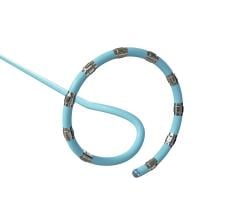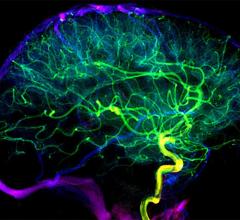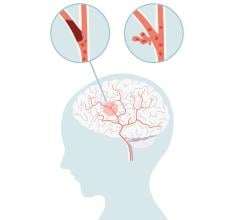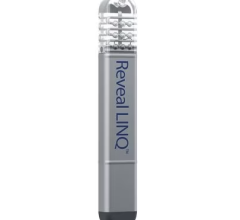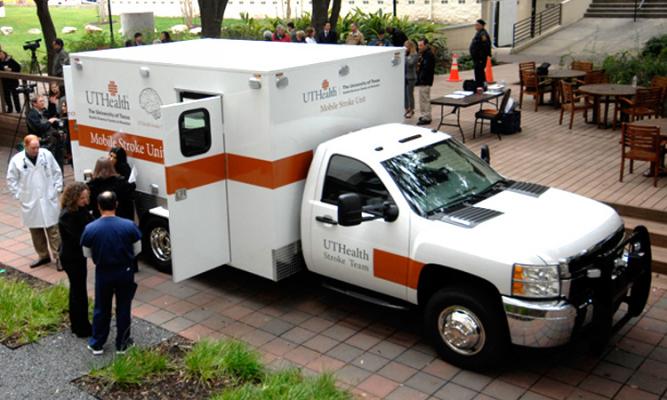
Image courtesy of UTHealth McGovern Medical School
August 16, 2019 — Every second counts for stroke patients, as studies show they can lose up to 27 million brain cells per minute. Researchers at The University of Texas Health Science Center at Houston (UTHealth) recently published new findings in Stroke that show patients transported to the hospital by mobile stroke unit (MSU) instead of standard ambulance received a clot-busting procedure an average of 10 minutes faster, which could potentially save up to 270 million neurons per patient.1
In 2014, McGovern Medical School at UTHealth was the first in the nation to launch a mobile stroke unit, a specially equipped ambulance for diagnosing and treating stroke rapidly before hospital arrival.
Take a 360 degree view inside a mobile stroke unit ambulance
“The quicker we get stroke victims treatment that will restore blood flow, the more brain tissue we can save,” said Alexandra Czap, M.D., vascular neurology fellow in the Department of Neurology at McGovern Medical School and first author of the paper. “This study shows that mobile stroke units like ours can be effective in streamlining time to treatment, potentially saving neurological function and ultimately improving quality of life in stroke patients.”
The study looked at data from 161 patients from Houston and two other locations from 2014 to 2018 who underwent intra-arterial thrombectomy after suffering an acute ischemic stroke, the most common kind, which is caused by a blockage in a cerebral artery. The only medical therapy known to treat ischemic stroke, tissue plasminogen activator (tPA), is not always able to clear a large clot. To perform the procedure, also known as endovascular thrombectomy, a vascular neurologist threads a catheter usually through a groin artery up to the blockage, where a small device inserted into the catheter is used to remove the clot.
“This is a hallmark paper because it shows that pre-hospital evaluation and management on a mobile stroke unit can significantly reduce time to endovascular treatment for patients with large artery clots,” said Amanda L. Jagolino-Cole, M.D., a teleneurologist and assistant professor in the Department of Neurology at McGovern Medical School, who was the senior author of the paper.
While on board the unit, an interdisciplinary team can begin the process to assess whether the patient needs a thrombectomy, including diagnostic imaging, neurological exam and the administration of tPA. That gives the treatment team a head start and upon arrival to the hospital, the patient can be taken quickly to the endovascular suite for the procedure.
“Our mobile stroke unit allows us to bring the hospital to the patient,” Czap said. “We can complete the necessary diagnostic testing and notify the hospital that we are coming, so that the appropriate teams can be ready. Streamlining this process allowed for one of our recent mobile stroke unit patients to complete treatment in under two hours from onset of symptoms. Going forward, identification of possible thrombectomy candidates on the unit can increase the accuracy of triage and increase the number of patients having the procedure, which we hope will lead to better patient outcomes.”
The paper also shows an overall improvement in endovascular thrombectomy metrics for all patients regardless of how they arrived to the hospital. This is significant because the procedure just started to be recognized as standard management for select stroke patients within the last five years, Jagolino-Cole said.
This research is part of the ongoing BEST-MSU study, a prospective comparative effectiveness trial that investigates the benefits of stroke treatment delivered using a mobile stroke unit compared to standard management by emergency medical services. The primary outcomes are patients’ functional status at 90 days and long-term health care utilization. The BEST-MSU study will complete enrollment in 2020.
Watch the VIDEO: Creating and Operating a Mobile Stroke Unit
For more information: www.ahajournals.org/journal/str
Related Content
Northwestern Medicine Mobile Stroke Unit Delivers Life-Saving Care 30 Minutes Sooner
Reference
1. Czap A.L., Grotta J.C., Parker S.A., et al. Emergency Department Door-to-Puncture Time Since 2014: Observations From the BEST-MSU Study. Stroke, published online June 11, 2019. https://doi.org/10.1161/STROKEAHA.119.025106


 March 05, 2024
March 05, 2024 
